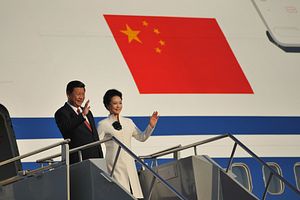Chinese President Xi Jinping is making his first tour of the Middle East this week, with stops in Saudi Arabia and Egypt. Those two countries have traditionally underpinned China’s Middle East relations, but they won’t be the only places Xi visits. He’ll also stop in Iran from January 22 to 23, making him the first Chinese president to do so since Jiang Zemin in 2002.
It’s no coincidence that Xi will be in Iran for the one-week anniversary of the official implementation of the Joint Comprehensive Plan for Action (JCPOA). On January 16, the International Atomic Energy Agency certified that Iran has complied with the deal’s terms by restricting its nuclear program, triggering the removal of sanctions on the Islamic Republic. China’s Foreign Minister Wang Yi congratulated all sides on the “solid step forward to the political and diplomatic settlement of the Iranian nuclear issue” and reminded the world that China “played a constructive role throughout the negotiation process.”
The JCPOA is a double-edged sword for China-Iran relations. On one hand, it opens the door for much deeper ties without Beijing having to risk international approbation. As such, China moved quickly to capitalize on the deal, pursuing deeper economic and military ties with Tehran. On the other hand, though, China isn’t the only country looking to capitalize on new access to Iran’s markets, meaning Beijing could lose a privileged position as European companies seek to enter the game.
Xi’s visit this week will make him the first world leader to come to Tehran since the JPCOA passed its “Implementation Day” milestone. It’s a clear reminder to Iran that China was a friend during the hard ties of sanctions – and a signal to the rest of the world that China has a leg up in the race to profit from the Iran deal.
Iranian economist Saeed Leylaz told Xinhua in an interview that Xi’s visit “will help China to remain Iran’s… biggest trade partner” in the face of growing competition from Europe. Leylaz also argued that focusing economic energies on China in the wake of sanctions relief would be most beneficial for Iran’s economy, calling it the “Chinese solution to Iran’s economy.”
Meanwhile, China’s ambassador to Iran, Pang Seng, extolled the growth of China-Iran trade, which reached $50 billion in 2014. Pang said that during Xi’s visit, the two sides would sign agreements on industrial capacity cooperation, oil and gas, and general investment. He also pointed out that progress on China’s “Belt and Road” initiative will help push bilateral ties to the next level, calling Iran a “key partner” in the project. The “Belt and Road” aims to create a trading and infrastructure network linking China with Europe – and the vision for the overland portion transits right through Iran.
China may face more competition in Iran in 2016, but it already has a sizable head-start in Iranian markets. And Beijing isn’t resting on its laurels either, but will use Xi’s visit to push forward investment and economic ties with one of China’s major oil sources.

































